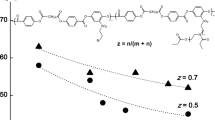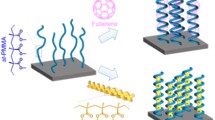Abstract
Multi-stimulus responsive weak polyelectrolyte brushes were grafted by surface-initiated atom transfer radical polymerization from spherical silica nanoparticles across a wide range of grafting densities approaching the limit of close packing of grafting sites: a regime not previously explored in the brush swelling literature. Brushes consisted of poly(2-(dimethylamino)ethyl methacrylate) (PDMAEMA) homopolymers or poly(2-(dimethylamino)ethyl methacrylate)-r-poly(4-metharyloyloxyazobenzene) random copolymers P (DMAEMA-r-MOAB) and were subjected to pH-, temperature-, and photoisomerization-induced swelling and deswelling. Homopolymer brushes were prepared at grafting densities ranging from 0.12 to 1.4 nm−2 and number average degrees of polymerization ranging from 300 to 1200. Two copolymer brushes with 8 mol% and 13 mol% of the nonionizable, photoresponsive MOAB units were compared with homopolymer brushes prepared at similar grafting densities and degrees of polymerization. Dynamic light scattering was used to measure the hydrodynamic radius of grafted nanoparticles, and thus brush thickness, in water. Brush swelling in response to increased DMAEMA protonation followed a single scaling behavior across the full range of degrees of polymerization and grafting densities. Incorporating azobenzene-containing MOAB comonomers introduced a modest photoresponsive control of brush swelling and decreased the brush thickness relative to the comparable PDMAEMA homopolymer brush, without affecting the scaling with respect to protonation. PDMAEMA brushes exhibited a pH-dependent lower critical solution temperature behavior, resulting in a thermal collapse of up to 50% upon heating. This work demonstrates that scaling behaviors previously tested at low grafting densities hold for extremely high grafting densities and that they are unaffected by moderate nonionizable comonomer content.








Similar content being viewed by others
References
Laloyaux X, Mathy B, Nysten B, Jonas AM (2010) Surface and bulk collapse transitions of thermoresponsive polymer brushes. Langmuir 26:838–847
Wang X, Wu C (1999) Light-scattering study of coil-to-globule transition of a poly(N-isopropylacrylamide) chain in deuterated water. Macromolecules 32:4299–4301
Wang X, Qiu X, Wu C (1998) Comparison of the coil-to-globule and the globule-to-coil transitions of a single poly( N -isopropylacrylamide) homopolymer chain in water. Macromolecules 31:2972–2976
Shi Y, Yang J, Zhao J, Akiyama H, Yoshida M (2016) Photo-controllable coil-to-globule transition of single polymer molecules. Polymer 97:309–313
Riley JK, Matyjaszewski K, Tilton RD (2014) Electrostatically controlled swelling and adsorption of polyelectrolyte brush-grafted nanoparticles to the solid/liquid interface. Langmuir 30:4056–4065
Minko S (2006) Responsive polymer brushes. J Macromol Sci Part C 46:397–420
Ballauff M (2007) Spherical polyelectrolyte brushes. Prog Polym Sci 32:1135–1151
Pincus P (1991) Colloid stabilization with grafted polyelectrolytes. Macromolecules 24:2912–2919
Zhulina EB, Birshtein TM, Borisov OV (1995) Theory of ionizable polymer brushes. Macromolecules 28:1491–1499
Lee AS, Butun V, Vamvakaki M, Armes SP, Pople JA, Gast AP (2002) Structure of pH-dependent block copolymer micelles: charge and ionic strength dependence. Macromolecules 35:8540–8551
Guo X, Ballauff M (2001) Spherical polyelectrolyte brushes: comparison between annealed and quenched brushes. Phys Rev E 64:51406
Liu G, Liu Z, Li N, Wang X, Zhou F, Liu W (2014) Hairy polyelectrolyte brushes-grafted thermosensitive microgels as artificial synovial fluid for simultaneous biomimetic lubrication and arthritis treatment. ACS Appl Mater Interfaces 6:20452–20463
Liu G, Cai M, Zhou F, Liu W (2014) Charged polymer brushes-grafted hollow silica nanoparticles as a novel promising material for simultaneous joint lubrication and treatment. J Phys Chem B 118:4920–4931
Saigal T, Dong H, Matyjaszewski K, Tilton RD (2010) Pickering emulsions stabilized by nanoparticles with thermally responsive grafted polymer brushes. Langmuir 26:15200–15209
Saigal T, Xu J, Matyjaszewski K, Tilton RD (2015) Emulsification synergism in mixtures of polyelectrolyte brush-grafted nanoparticles and surfactants. J Colloid Interface Sci 449:152–159
Liu G, Cai M, Wang X, Zhou F, Liu W (2014) Core-shell-corona-structured polyelectrolyte brushes-grafting magnetic nanoparticles for water harvesting. ACS Appl Mater Interfaces 6:11625–11632
Zhulina EB, Borisov OV, Priamitsyn VA (1990) Theory of steric stabilization of colloid dispersions by grafted polymers. J Colloid Interface Sci 137:495–511
Israels R, Leermakers FAM, Fleer GJ, Zhulina EB (1994) Charged polymeric brushes: structure and scaling relations. Macromolecules 27:3249–3261
Borisov OV, Zhulina EB, Birshtein TM (1994) Diagram of the states of a grafted polyelectrolyte layer. Macromolecules 27:4795–4803
Zhulina EB, Borisov OV (1997) Structure and interaction of weakly charged polyelectrolyte brushes: self-consistent field theory. J Chem Phys 107:5952–5967
de Gennes PG (1980) Conformations of polymers attached to an interface. Macromolecules 13:1069–1075
Zhulina EB, Borisov OV (1996) Polyelectrolytes grafted to curved surfaces. Macromolecules 29:2618–2626
Pryamitsyn VA, Leermakers FAM, Fleer GJ, Zhulina EB (1996) Theory of the collapse of the polyelectrolyte brush. Macromolecules 29:8260–8270
Borisov OV, Zhulina EB (1998) Effects of ionic strength and charge annealing in star-branched polyelectrolytes. Eur Phys J B 4:205–217
Wolterink JK, Leermakers FAM, Fleer GJ, Koopal LK, Zhulina EB, Borisov OV (1999) Screening in solutions of star-branched polyelectrolytes. Macromolecules 32:2365–2377
Tran Y, Auroy P, Lee LT (1999) Determination of the structure of polyelectrolyte brushes. Macromolecules 32:8952–8964
Ahrens H, Forster S, Helm CA, Kumar NA, Naji A, Netz RR, Seidel C (2004) Nonlinear osmotic brush regime: experiments, simulations and scaling theory. J Phys Chem B 108:16870–16876
Sanjuan S, Perrin P, Pantoustier N, Tran Y (2007) Synthesis and swelling behavior of pH-responsive polybase brushes. Langmuir 23:5769–5778
Lego B, Skene WG, Giasson S (2010) Swelling study of responsive polyelectrolyte brushes grafted from mica substrates: effect of pH, salt, and grafting density. Macromolecules 43:4384–4393
Hariharan R, Biver C, Mays J, Russel WB (1998) Ionic strength and curvature effects in flat and highly curved polyelectrolyte brushes. Macromolecules 31:7506–7513
Hariharan R, Biver C, Russel WB (1998) Ionic strength effects in polyelectrolyte brushes: the counterion correction. Macromolecules 31:7514–7518
Mei Y, Ballauff M (2005) Effect of counterions on the swelling of spherical polyelectrolyte brushes. Eur Phys J B 16:341–349
Van Der Maarel JRC, Groenewegen W, Egelhaaf SU, Lapp A (2000) Salt-induced contraction of polyelectrolyte diblock copolymer micelles. Langmuir 16:7510–7519
Groenewegen W, Egelhaaf SU, Lapp A, Van Der Maarel JRC (2000) Neutron scattering estimates of the effect of charge on the micelle structure in aqueous polyelectrolyte diblock copolymer solutions. Macromolecules 33:3283–3293
Guo X, Ballauff M (2000) Spatial dimensions of colloidal polyelectrolyte brushes as determined by dynamic light scattering. Langmuir 16:8719–8726
Dukes D, Li Y, Lewis S, Benicewicz B, Schadler L, Kumar SK (2010) Conformational transitions of spherical polymer brushes: synthesis, characterization, and theory. Macromolecules 43:1564–1570
Somcynsky T (1982) The lower critical solution temperature (LCST) of non-polar polymer solutions: an introduction. Polym Eng Sci 22:58–63
Plamper FA, Schmalz A, Ballauff M, Müller AHE (2007) Tuning the thermoresponsiveness of weak polyelectrolytes by pH and light: lower and upper critical-solution temperature of poly(N,N-dimethylaminoethyl methacrylate). J Am Chem Soc 129:14538–14539
Zhang H, Guo S, Fan W, Zhao Y (2016) Ultrasensitive pH-induced water solubility switch using UCST polymers. Macromolecules 49:1424–1433
Yamamoto S, Pietrasik J, Matyjaszewski K (2008) Temperature-and pH-responsive dense copolymer brushes prepared by ATRP. Macromolecules 41:7013–7020
Niskanen J, Wu C, Ostrowski M, Fuller GG, Hietala S, Tenhu H (2013) Thermoresponsiveness of PDMAEMA. Electrostatic and Stereochemical Effects Macromolecules:2331–2340
Karjalainen E, Aseyev V, Tenhu H (2014) Influence of hydrophobic anion on solution properties of PDMAEMA. Macromolecules 47:2103–2111
Lee H, Pietrasik J, Matyjaszewski K (2006) Phototunable temperature-responsive molecular brushes prepared by ATRP. Macromolecules 39:3914–3920
Zhou F, Shu W, Welland ME, Huck WTS (2006) Highly reversible and multi-stage cantilever actuation driven by polyelectrolyte brushes. J Am Chem Soc 128:5326–5327
Yuan W, Chen X (2016) Star-shaped and star-block polymers with a porphyrin core: from LCST-UCST thermoresponsive transition to tunable self-assembly behavior and fluorescence performance. RSC Adv 6:6802–6810
Yuan T, Dong J, Han G, Wang G (2016) Polymer nanoparticles self-assembled from photo-, pH-, and thermo-reponsive azobenzene-functionalized PDMAEMA. RSC Adv 6:10904–10911
Wang G, Dong J, Yuan T, Zhang J, Wang L, Wang H (2016) Visible light and pH responsive polymer-coated mesoporous silica nanohybrids for controlled release. Macromol Biosci 16:990–994
Riley JK, Tilton RD (2016) Sequential adsorption of nanoparticulate polymer brushes as a strategy to control adhesion and friction. Langmuir 32:11440–11447
Riley JK, Matyjaszewski K, Tilton RD (2018) Friction and adhesion control between adsorbed layers of polyelectrolyte brush-grafted nanoparticles via pH-triggered bridging interactions. J Colloid Interface Sci 526:114–123
Nordgren N, Rutland MW (2009) Tunable nanolubrication between dual-responsive polyionic grafts. Nano Lett 9:2984–2990
Kumar GS, Neckers DC (1989) Photochemistry of azobenzene-containing polymers. Chem Rev 89:1915–1925
Park JY, Umashankar M, Huh DS (2016) Effect of UV illumination on the fabrication of honeycomb-patterned film in the photo-responsive poly (methylmethacrylate/azobenzene) copolymer. Macromol Res 24:350–358
Harnoy AJ, Slor G, Tirosh E, Amir RJ (2016) The effect of photoisomerization on the enzymatic hydrolysis of polymeric micelles bearing photo-responsive azobenzene groups at their cores. Org Biomol Chem 14:5813–5819
Norikane Y, Tanaka S, Uchida E (2016) Azobenzene crystals swim on water surface triggered by light. CrystEngComm 18:7225–7228
Yu Y, Nakano M, Ikeda T (2003) Directed bending of a polymer film by light. Nature 425:145
Ohno K, Morinaga T, Takeno S, Tsujii Y, Fukuda T (2007) Suspensions of silica particles grafted with concentrated polymer brush: effects of graft chain length on brush layer thickness and colloidal crystallization. Macromolecules 40:9143–9150
Lee H, Pietrasik J, Sheiko SS, Matyjaszewski K (2010) Stimuli-responsive molecular brushes. Prog Polym Sci 35:24–44
Yan J, Pan X, Schmitt M, Wang Z, Bockstaller MR, Matyjaszewski K (2016) Enhancing initiation efficiency in metal-free surface-initiated atom transfer radical polymerization (SI-ATRP). ACS Macro Lett 5:661–665
Bandara HMD, Burdette SC (2012) Photoisomerization in different classes of azobenzene. Chem Soc Rev 41:1809–1825
Lee H, Son SH, Sharma R, Won Y-Y (2011) A discussion of the pH-dependent protonation behaviors of poly(2-(dimethylamino)ethyl methacrylate) (PDMAEMA) and poly (ethylenimine-ran-2-ethyl-2-oxazoline) (P (EI-r-EOz)). J Phys Chem B 115:844–860
van de Wetering P, Zuidam NJ, van Steenbergen MJ, van der Houwen OAGJ, Underberg WJM, Hennink WE (1998) A mechanistic study of the hydrolytic stability of poly(2-(dimethylamino)ethyl methacrylate). Macromolecules 31:8063–8068
Brown W, Fundin J, de Graca MM (1992) Poly (ethylene oxide)-sodium dodecyl sulfate interactions studied using static and dynamic light scattering. Macromolecules 25:7192–7198
Doncom KEB, Blackman LD, Wright DB, Gibson MI, O’Reilly RK (2017) Dispersity effects in polymer self-assemblies: a matter of hierarchical control. Chem Soc Rev 46:4119
Shusharina NP, Nyrkova IA, Khokhlov AR (1996) Diblock copolymers with a charged block in a selective solvent: micellar structure. Macromolecules 29:3167–3174
Fournier D, Hoogenboom R, Thijs HML, Paulus RM, Schubert US (2007) Tunable pH-and temperature-sensitive copolymer libraries by reversible addition-fragmentation chain transfer copolymerizations of methacrylates. Macromolecules 40:915–920
Puntoriero F, Ceroni P, Balzani V, Bergamini G, Vögtle F (2007) Photoswitchable dendritic hosts: a dendrimer with peripheral azobenzene groups. J Am Chem Soc 129:10714–10719
Acknowledgments
This material is based on work supported by the Mellon College of Science and the Carnegie Institute of Technology Dean’s Initiative and by the National Science Foundation under grant DMR-1501324.
Author information
Authors and Affiliations
Corresponding author
Ethics declarations
Conflict of interest
The authors declare that they have no conflict of interest.
Additional information
Publisher’s note
Springer Nature remains neutral with regard to jurisdictional claims in published maps and institutional affiliations.
Electronic supplementary material
ESM 1
(PDF 400 kb)
Rights and permissions
About this article
Cite this article
Iqbal, D., Yan, J., Matyjaszewski, K. et al. Swelling of multi-responsive spherical polyelectrolyte brushes across a wide range of grafting densities. Colloid Polym Sci 298, 35–49 (2020). https://doi.org/10.1007/s00396-019-04585-4
Received:
Revised:
Accepted:
Published:
Issue Date:
DOI: https://doi.org/10.1007/s00396-019-04585-4




